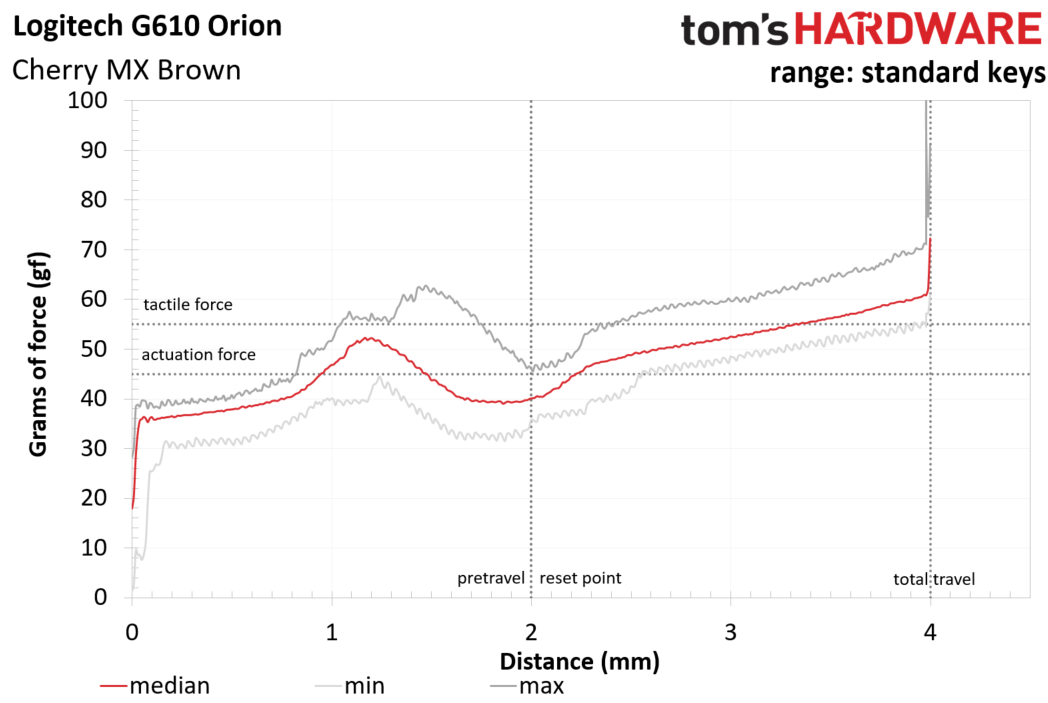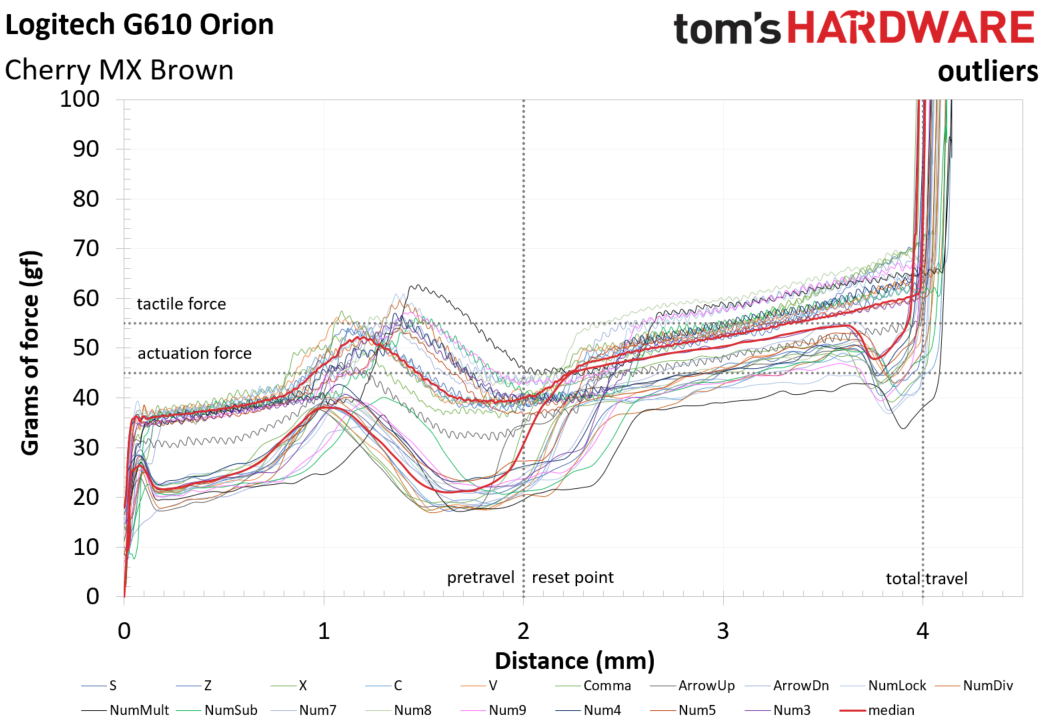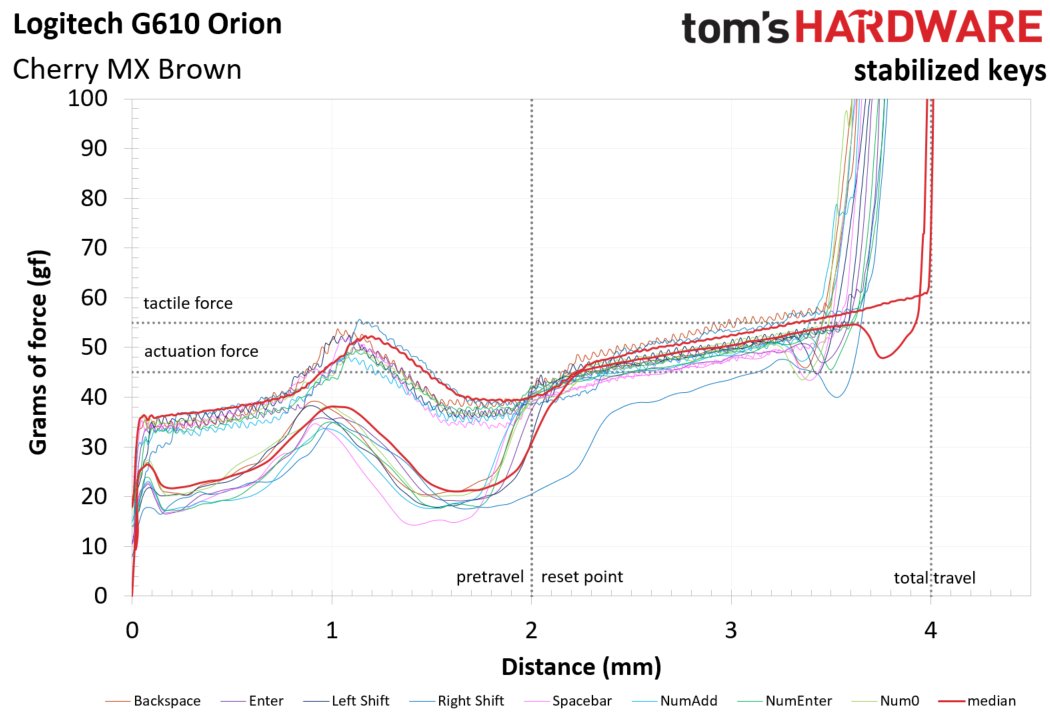Logitech G610 Orion Brown Keyboard Review
Why you can trust Tom's Hardware
Benchmark Results
Key Rollover Testing
The G610 Orion Brown comes with 26-key rollover (26KRO), which is in practice equivalent to n-key rollover (NKRO). Using Switch Hitter and the Aqua Key Test, it was not until I pressed both hands flat onto the keyboard that I found certain keys not registering. As this is a situation you would not expect to ever occur during normal use, this presents no serious limit to how many keys you can hold down at the same time.
Audio Testing
Because of the closed chassis and the taut build of the keyboard, the switches (which aren’t very loud to begin with) were not particularly noisy, apart from the occasional distracting “ping” sound mentioned above. Although plate ping is not unheard of, and some boards like the Corsair K70 have it on all keys rather than on just a few like it was on our G610 Orion Brown, I found that the inconsistency made it stand out more. In fact, at first I thought it was a notification noise coming from the computer rather than plate ping coming from the keyboard.
The sound itself has a distinct plasticy tone, and there is a considerable difference in the type of sound depending on whether you bottom out during keystrokes or not. When bottoming out, you hear a distinct, loud, plastic “clack,” whereas when you don’t bottom out, you get sort of a vague scratching sound.
Switch Testing
The charts below represent testing performed on the switches that are mounted on this keyboard. For a primer on the what, how, and why of this testing, read our Mechanical Keyboard Switch Testing Explained reference article.
The lines on the charts are force curves showing the characteristics of the key travel, the distance and rebound of the key travel, the force required to depress the key, and the rebound force applied by the spring to reset the switch.
The squiggly line is the press, and the smoother line below it is the rebound.
The dotted gray lines show a given switch specification as provided by the switch manufacturer. They’re not a measurement; they’re merely a reference. For the metrics we can measure, they’re present to show how closely the switch performance matches the manufacturer spec. Some specifications we cannot measure, but we’ve shown them here so you can see what they’re supposed to be, at least.
Get Tom's Hardware's best news and in-depth reviews, straight to your inbox.
The force curve above shows the median of all the switches on this keyboard (red line). Bear in mind that the median curve is drawn from all switches on this keyboard, including any outliers.
The black line is the force curve of a single switch on this keyboard, chosen at random. The graph gives an indication of the kind of keyfeel you can expect from the keyboard.
Just as we saw with the Cherry MX RGB Brown switches on the G.Skill Ripjaws KM780, these switches will give you a gently tactile keyfeel. In fact, we’ll just repeat ourselves verbatim here:
If you remove the tactile bump from the force curve, you can see that it’s almost a straight line slanting upwards. However, the tactile bump takes up quite a bit of the travel--about 0.8-2.2mm--so there’s kind of a lot happening through the keypress. The full scope of the tactile bump is rather shallow, too; from peak to nadir is just about 14gf (~38-52gf), and in fact the peak of the bump is less than 10gf above where the force would be if this was a completely linear switch.One curious finding is that these Cherry MX RGB Brown switches actuate just before the arc of the tactile bump ends. Further note that the peak of the tactile bump occurs about 1.3mm before the actuation point. That’s quite a distance. Bottoming out the switches takes only about 60gf.
However, there’s one discrepancy between these two keyboards that’s worth noting: On the median, the G.Skill Ripjaws KM780’s Cherry MX RGB Brown switches reach the end of their travel at about 3.85mm, whereas the Logitech G610’s switches are right at the 4mm mark.
This chart shows the range of the switch performance on the Logitech G610 Orion. Note that we’ve omitted the rebound line for the sake of clarity.
In a bit of a reversal from what we’ve seen from most other keyboards’ switches, both the maximum and minimum lines are consistent with the median just after the actuation point. The max is just under 10gf off of the median, and the min is ~5gf below. That’s a fairly tight range of variation--just ~15gf.
However, there’s a bit of chaos around the tactile bump. Again, oddly, the max force hangs tight to the median (just a couple of gf above it), whereas the min runs about 4-6gf below. From the beginning of the tactile bump until the actuation point, both the max and min show plenty of unevenness and inconsistency.
This chart shows the force curves of all of the standard keys--the stabilized key force curves have been omitted.
Here, you can see confirmation of what the range told us: The latter part of the travel shows few outliers (and even those aren’t particularly significant), whereas the force curves around the tactile bump have a handful of ugly outliers.
The key that stands out the most here is NumMult, which is way off the median, starting with the tactile bump. It hit the bump late, then shot upward in terms of force required. It eventually settled down around the actuation point then required a bit of extra force through the end of the travel.
That key is not alone; several others have more or less the same shape, just not to such an obvious degree. In fact, most of the outliers on the Logitech G610 Orion show up around the tactile bump. They hit it either a bit early or a bit late, and many of them end up completing the tactile bump around 0.3-0.4mm past the median. Further, many have somewhat jagged curves, further affecting the consistency and feel of these switches around the tactile bump and actuation point.
There are even more switches that complete the tactile bump past the median, but the differences are minor enough (and there are so many of them) that we opted not to include them here.
Some switches show total travel that extends past the 4mm mark. This is not especially interesting--none extend more than about 0.1mm past it--but it’s worth noting.
A final outlier of note the ArrowUp key, which starts out with lower-than-median force required and stays that way throughout the travel.
Also note that although a handful of switches require some extra force towards the end of travel, none are especially egregious; as we noted above, none are more than ~10-12gf off of the median.
Although we never expect the stabilized keys to have the same force curves as the standard keys, the stabilized Cherry MX Brown switches on the Logitech G610 Orion are quite close for the most part--until the end of the travel.
Indeed, there’s hardly any deviation from the median except at the tactile bump (more of the same issues discussed in the outliers section above), although the wonky rebound curve of the Right Shift key sticks out like a sore thumb.
The full key travels are fairly far off from the median (although they are consistent to each other), reaching their respective ends at between 3.4-3.7mm instead of 4mm. That’s a fairly large gap.
MORE: Best Deals
MORE: How We Test Mechanical Keyboards
MORE: Mechanical Keyboard Switch Testing Explained
MORE: All Keyboard Content




